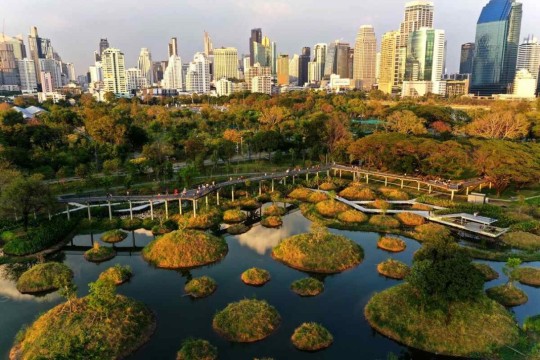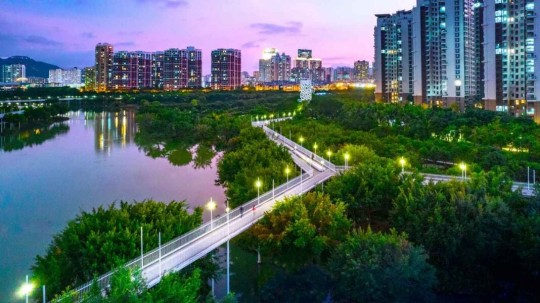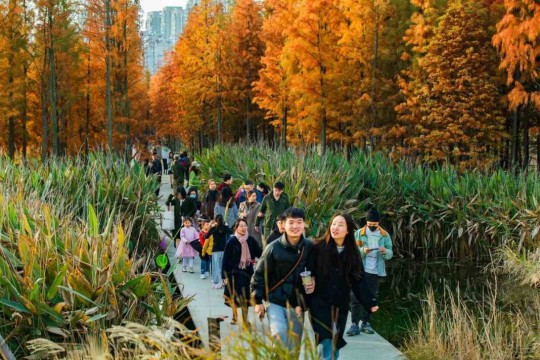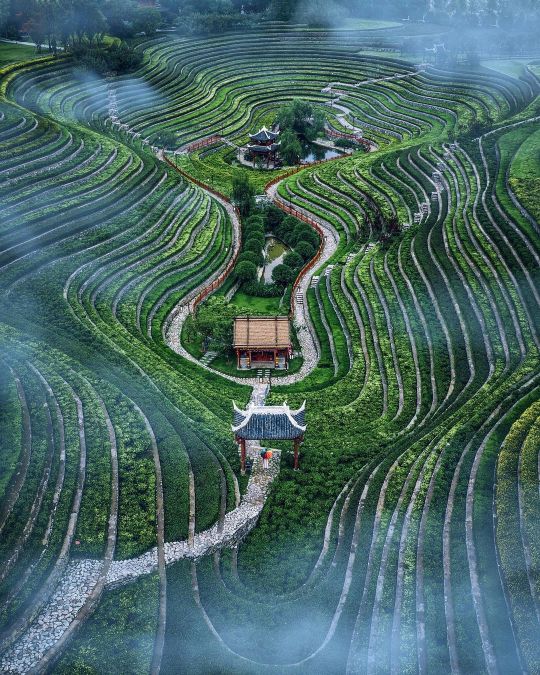#landscape architecture
Explore tagged Tumblr posts
Text





nordic pavillion ~ sverre fehn | images © åke e:son lindman
#architecture#museum#pavilion#light#concrete#structure#sliding glass doors#hardscape#landscape architecture#trees#multi-use#flexibility
147 notes
·
View notes
Text
"In China, a landscape architect is reimagining cities across the vast country by working with nature to combat flooding through the ‘sponge city’ concept.
Through his architecture firm Turenscape, Yu has created hundreds of projects in dozens of cities using native plants, dirt, and clever planning to absorb excess rainwater and channel it away from densely populated areas.
Flooding, especially in the two Chinese heartlands of the commercial south and the agricultural north, is becoming increasingly common, but Yu says that concrete and pipe solutions can only go so far. They’re inflexible, expensive, and require constant maintenance. According to a 2021 World Bank report, 641 of China’s 654 largest cities face regular flooding.
“There’s a misconception that if we can build a flood wall higher and higher, or if we build the dams higher and stronger, we can protect a city from flooding,” Yu told CNN in a video call. “(We think) we can control the water… that is a mistake.”

Pictured: The Benjakitti Forest Park in Bangkok
Yu has been called the “Chinese Olmstead” referring to Frederick Law Olmstead, the designer of NYC’s Central Park. He grew up in a little farming village of 500 people in Zhejiang Province, where 36 weirs channel the waters of a creek across terraced rice paddies.
Once a year, carp would migrate upstream and Yu always looked forward to seeing them leap over the weirs.
This synthesis of man and nature is something that Turenscape projects encapsulate. These include The Nanchang Fish Tail Park, in China’s Jiangxi province, Red Ribbon Park in Qinghuandao, Hebei province, the Sanya Mangrove Park in China’s island province of Hainan, and almost a thousand others. In all cases, Yu utilizes native plants that don’t need any care to develop extremely spongey ground that absorbs excess rainfall.

Pictured: The Dong’an Wetland Park, another Turescape project in Sanya.
He often builds sponge projects on top of polluted or abandoned areas, giving his work an aspect of reclamation. The Nanchang Fish Tail Park for example was built across a 124-acre polluted former fish farm and coal ash dump site. Small islands with dawn redwoods and two types of cypress attract local wildlife to the metropolis of 6 million people.
Sanya Mangrove Park was built over an old concrete sea wall, a barren fish farm, and a nearby brownfield site to create a ‘living’ sea wall.
One hectare (2.47 acres) of Turenscape sponge land can naturally clean 800 tons of polluted water to the point that it is safe enough to swim in, and as a result, many of the sponge projects have become extremely popular with locals.
One of the reasons Yu likes these ideas over grand infrastructure projects is that they are flexible and can be deployed as needed to specific areas, creating a web of rain sponges. If a large drainage, dam, seawall, or canal is built in the wrong place, it represents a huge waste of time and money.

Pictured: A walkway leads visitors through the Nanchang Fish Tail Park.
The sponge city projects in Wuhan created by Turenscape and others cost in total around half a billion dollars less than proposed concrete ideas. Now there are over 300 sponge projects in Wuhan, including urban gardens, parks, and green spaces, all of which divert water into artificial lakes and ponds or capture it in soil which is then released more slowly into the sewer system.
Last year, The Cultural Landscape Foundation awarded Yu the $100,000 Oberlander Prize for elevating the role of design in the process of creating nature-based solutions for the public’s enjoyment and benefit."
-via Good News Network, August 15, 2024
#china#wuhan#thailand#bangkok#landscape#wetlands#sponge city#landscape architecture#flooding#climate action#parks#public park#green architecture#sustainability#good news#hope
1K notes
·
View notes
Text

#landscape#interior design#architecture#art#minimal#simplicity#interior#minimalism#design#residential architects#architettura#architectdesign#homedesign#archtecture#architecturephotography#amazingarchitecture#archilovers#landscape architecture#landscape art#garden design#garden decor#garden architecture#botanic garden#botanical#botany
17 notes
·
View notes
Text

Kyoto Imperial Palace Garden, Japan with my Mamiya C330 on Kodak Portra 160.
@kevintadge
#photography#film#photo#photographers on tumblr#japan#landscape#120#kodak#medium format#mamiya#6x6#garden#kyoto#nature#film photography#landscape architecture#mamiya c330#kodak portra 160#portra
210 notes
·
View notes
Text

And March said, no more being sad because spring is here.
10 notes
·
View notes
Text

Penn State Arboretum - September 15th 2024
#nature#photographers on tumblr#original photography#lensblr#architecture#landscape architecture#early autumn#garden
24 notes
·
View notes
Text










The James Garden Pavilion, Brisbane, Australia,
Designed by UME Architecture
#art#design#architecture#minimalism#luxury#luxury house#luxury home#pavilion#gardens#landscaping#landscape architecture#james garden#new farm#australia#brisbane#UME architecture
78 notes
·
View notes
Text

Jan van der Groen, Den Nederlandtsen Hovenier (The Netherlandish Gardener), Designs for Flower Beds, 1659-1671
#Jan van der Groen#art#design#garden#landscape#landscape architecture#diagram#designs for flower beds#Den Nederlandtsen Hovenier#The Netherlandish Gardener#square#organization#plan
113 notes
·
View notes
Text

Fort Canning Tree Tunnel," Singapore,
Fort Canning Tree tunnel connects Penang Road with Fort Canning Park and ends with a spiral staircase looking up to a large Yellow Rain Tree. Fort Canning Park is open 24/7 and there is no entrance fee for visiting it.
Fort Canning was built in 1859 and used by the British Army and then the Japanese Army during the occultation in WWII. It was handed over to the Singapore Armed Forces in 1963 and converted into a public park in 1972.
#art#design#stairwell#stairway#architecture#staircase#spiral staircase#stairs#staircases#public space#crossroad#underground#singapore#tunnel#tree#fort canning#garden#landscape architecture
160 notes
·
View notes
Photo

” Behold the fingerprint of the land,” Guizhou, China.
Nestled in the rolling hills of Guizhou, a remarkable tea plantation bears witness to the astounding beauty of nature's patterns. Photo by: @youknowcyc
#art#landscaping#agriculture#china#guizhou#plantation#earth#nature#green#drone photography#tea#hills#zen#retreat#landscape architecture
1K notes
·
View notes
Text

MHA House, 1947, A Quincy Jones, Jim Charlton
MHA: SITE OFFICE (2019)
Four friends, returning from WWII, pooled their money and bought an acre of land. They hired a pre-Eichler A Quincy Jones, along with Whitney R. Smith, and engineer Edgardo Contin, and built four homes. The group formed the non profit Mutual Housing Association, and through this many more homes were then built in the area, several by renowned mid century architects.
This video takes us on a short tour of MHA's site office and studio, which was converted to a residence in 1956, and more recently restored by architect-owner Cory Buckner. The site was planned so that the houses sat on its corners, at angles to the street and each other, with a central communal pool and play area, which diminishes the sense of internal boundaries, and allows uninterrupted views of the greenery.
#mid century modern#architecture#quincy jones#los angeles#tropical modern#mha house#landscape architecture#cory buckner
295 notes
·
View notes
Text







la platanera ~ alberto kalach / tax | photos: yoshihiro koitani
#architecture#houses#library#old and new#inside outside#stairs#reuse#gardens#garden#courtyard#hardscape#landscape architecture#mexico
198 notes
·
View notes
Text

Garden path. Victorian gardens: The art of beautifying suburban home grounds. 1870.
Internet Archive
130 notes
·
View notes
Text

#landscape#interior design#architecture#art#minimal#simplicity#interior#minimalism#design#residential architects#architettura#architectdesign#homedesign#archtecture#architecturephotography#amazingarchitecture#archilovers#landscape architecture#landscape art#garden design#garden decor#garden architecture#botanic garden#botanical#botany
35 notes
·
View notes
Text

Nordic — Office of Architecture
Nanchang Wave, China, 2019
#definitely Niemeyer inspired#nordic office of architecture#architecture#modernist architecture#contemporary architecture#architectural design#landscape architecture
98 notes
·
View notes